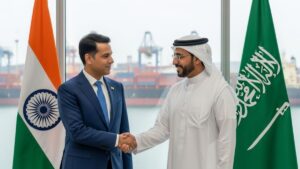Introduction to the Doomsday Clock
The Doomsday Clock, established by the Bulletin of the Atomic Scientists, is a metaphorical representation of the proximity of humanity to global catastrophes, primarily caused by man-made technologies and environmental challenges. Recently, this symbolic clock has drawn significant attention due to its alarming setting close to midnight.
Historical Background of Doomsday Clock

Origin
The Doomsday Clock was created in 1947, two years after the atomic bombings of Hiroshima and Nagasaki. The concept was developed by scientists who worked on the Manhattan Project and were deeply concerned about the nuclear arms race following World War II. Artist Martyl Langsdorf, a member of the Bulletin, designed the original clock.
Purpose
Initially, the clock was a symbol of nuclear threat. It has since evolved to encompass a broader range of dangers, including climate change, emerging technologies, and biological hazards.
Current Setting and Significance of Doomsday Clock
Setting in 2024
As of 2024, the Doomsday Clock is set at 90 seconds to midnight. This setting is based on a comprehensive assessment of current global threats and is the closest the clock has ever been to midnight.
Underlying Factors of Doomsday Clock
Several factors influenced this setting:
Nuclear Threats: The growing tensions among nuclear powers, particularly the United States, Russia, and China, have heightened the risk of nuclear conflict.
Climate Change: 2023 marked the hottest year on record, with rising global greenhouse gas emissions and inadequate efforts to combat climate change.
Technological Advancements: The unchecked growth of disruptive technologies like artificial intelligence poses new risks, including the spread of disinformation and the potential misuse of AI in warfare.
Criticism and Debate of Doomsday Clock
Despite its symbolic importance, the Doomsday Clock has faced criticism for its subjective nature. Critics argue that its settings are based on guesswork rather than empirical evidence and question the methodology used to calculate the time. Some view it as an outdated PR stunt, with its relevance and effectiveness in today’s world being a topic of debate.
The Bulletin’s Role
Creation and Maintenance
The Bulletin of the Atomic Scientists, founded by Albert Einstein and J. Robert Oppenheimer, has been maintaining the Doomsday Clock since its inception. The organization comprises scientists and other experts who assess global threats and decide the clock’s setting.
Aim and Impact
The primary aim of the Bulletin and the Doomsday Clock is not to incite fear but to spur action towards mitigating these existential threats. The clock serves as a reminder of the urgent need for collaborative efforts to address the challenges facing humanity.
Important Questions Related to Exams
- When was the Doomsday Clock created, and what historical events prompted its establishment?
- Who designed the original Doomsday Clock, and what was its initial purpose?
- In 2024, how many seconds to midnight is the Doomsday Clock set, and why is this setting considered alarming?
- What are the underlying factors influencing the current setting of the Doomsday Clock in 2024?
- What role do nuclear threats, climate change, and technological advancements play in the assessment of global risks for the Doomsday Clock?
- What criticisms has the Doomsday Clock faced, and why do some consider it a topic of debate in today’s world?
- Who is responsible for maintaining the Doomsday Clock, and how does the Bulletin of the Atomic Scientists determine its setting?
- What is the primary aim of the Bulletin of the Atomic Scientists and the Doomsday Clock, and how does it impact global perspectives on existential threats?
Kindly share your responses in the comment section!!




 India, Saudi Arabia Form Joint Working G...
India, Saudi Arabia Form Joint Working G...
 Dubai Launches ‘One Freezone Passport’ t...
Dubai Launches ‘One Freezone Passport’ t...
 Over 500 Humanoid Robots Compete at Worl...
Over 500 Humanoid Robots Compete at Worl...

